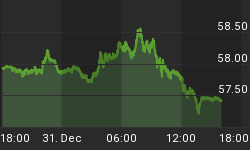Another 12.5/32nds gain for TNotes (2.96% yield on the on-the-run 10y note), and this rally is starting to become almost ordinary with the 6th gain of the last 7 sessions. Alas, the losses on stocks are starting to grow more ordinary as well: the S&P dropped 3.1%, and this time the surge in volume wasn't due to the Russell rebalancing. The 1.55bln shares was not a record-breaker, or as high as the volumes we saw in May...but neither was it the pedestrian total we were seeing in the first part of the year. With the exception of the March quadruple-witching, today's equity volume exceeded that printed for any day during the first quarter of the year.
There appeared to be a catalyst in the form of a Consumer Confidence figure that was released at 52.9, down sharply from last month's pre-revision 63.3 and about ten points below forecast. This is a surprise, with both "present situation" and "expectations" portions of the index dropping, but really all that it did was unwind last month's surprise jump (which, many observers noted, was concentrated in the "expectations" component). See the chart below - we're merely back in the recent range. The failure of forecasters here wasn't because the data was awful this month, but because it was improbably strong last month. So the fault is not in the stars, but in ourselves.

Not a reason in itself for -3%.
Or, more specifically, in themselves, meaning economists, since I never believed the economy was improving sharply last month!
The important part of the number, that is the employment questions, were essentially unchanged. This is not a horrible report, and while it may have served as the reason that commentators could point to, the locus of all fears, I think the real reason for both stocks' decline today and bonds' rally - both of which, after all, have been moving along nicely for several days prior to this data - is deeper than that.
Banks are due to repay to the ECB tomorrow the lusty sum of 442 billion euros, about $540billion at the current exchange rate, which was lent by the ECB last year as the crisis was ebbing. The ECB is offering a three-month facility at the same time that the 12-month loans roll off. Now, this seems like a simple transaction: borrow for 3 months to pay back the 1-year loan. The problem is that the 3-month loan carries a 1% interest rate, which is substantially above the currently-clearing interbank lending rate. Thus, institutional investors who are already nervous are worried that a high "roll" into the new facility implies that the interbank funding markets aren't really operating, or are closed to certain names. Estimates of the amount that may be rolled seem to be around 200bln to 300bln Euro although I have seen some higher guesses. The real question is the composition of the banks who are borrowing directly from the ECB - are certain banks being shut out, or borrowing this way so as not to be seen taking large quantities of deposits interbank? - but we are not likely to know important details there.
Now, the ECB is still lending almost a trillion Euro to various banks, so it isn't like a high take-up of the 3-month facility would be unprecedented. The issue is just that this quite-large loan maturity occurs when the system is already a bit stressed and investors a bit nervous. It is just event risk.
I suspect that the ECB will announce the results of the auction and that will be it, and after the market's initial reaction we won't be able to slice and dice the data any further and that particular issue will fade for another three months. But that isn't the only source of event risk, since ADP is being released and, lest we forget, both stocks and bonds made very messy technical breaks today. The speed of the return to the bottom of the stock range, and the decisiveness of the break to lower yields as well, suggests to me that these trends have significantly further to run. I am working hard to minimize my exposure to these event risks.
















